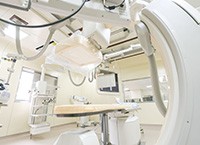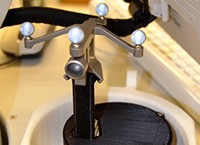| - UPCOMING WORKSHOP INFORMATION - |
| Advancing Medical Care through Discovery in the Physical Sciences Joint DOE / NIH Workshop Date: March 16-17, 2023 Location: CEBAF Center Auditorium |
A better way to detect breast cancers. Enhanced radiation therapies for malignant tumors. Potential new treatments for Alzheimer’s and cystic fibrosis. All share a little history and not a little DNA with fundamental physics research.
That’s because improved devices and technologies devised by scientists and users at Jefferson Lab to advance nuclear research and our understanding of the subatomic particles that make up the universe are also supporting critical advancements in nuclear medicine and biomedical imaging.
Efforts include:
- Development of tiny “scintillating” fibers that help treatment centers target cancer cells.
- A novel way to create a therapeutic isotope that’s commonly used for research into cancer and inflammatory disease therapies.
- 3D breast-imaging improvements so that cancers buried deep within dense tissue “light up,” giving them no place to hide.
Discoveries and cutting-edge technologies that scientists and engineers develop to advance our understanding of basic physics — such as faster, cheaper and more precise radiation detectors, for instance — get adopted and adapted, enabling greater precision in biomedical research, in spotting cancer cells earlier, and in helping drive breakthroughs that improve human health, treat illnesses and save lives.
Cherenkov radiation is notable for its faint blue hue while in liquids, like the bluish glow from an underwater nuclear reactor. More recently, this light signal has been used to image substances — and sparked keen interest in its use to detect and measure radiation — within the human body. This makes it valuable for cancer diagnosis and treatment, for medical imaging of radioisotopes and external beam radiotherapy. At Jefferson Lab, scientists are devising a compact, user-friendly instrument to help them tell one particle type from another in nuclear physics experiments. The new technologies being explored in this device could lead to enhancements in cancer detection and treatment.
Nearly half a million cancer patients receive radiation therapy every year in the U.S. For doctors, it can be a challenge to irradiate hard-to-reach cancers and to measure just how much radiation a patient is receiving in real time. Basic nuclear physics researchers, meanwhile, have developed detector technologies that measure the flashes of light produced when a particle passes through scintillating material in experiments. Now, an award-winning medical system uses novel scintillating fibers based on these technologies. With it, doctors can insert scintillating fibers into the human body via a catheter or other device to detect, monitor and alter radiation doses to ensure cancer patients are getting the right treatment in the right places, and also reduce the damage to nearby non-cancerous tissue.
A medical isotope made from radioactive copper, called Cu-67, is an important therapeutic analog for image-guided radiopharmaceutical therapy for cancer and inflammatory diseases. Jefferson Lab is studying the viability of using its Low Energy Recirculator Facility to produce Cu-67 in a novel way, which may result in another avenue to secure this rare and valuable radioisotope for use in the patients who need it most.
Jefferson Lab has a long history of aiding efforts in research and development of a wide range of detector technologies to aid physicians in earlier and more accurate diagnosis and treatment of breast cancer in nuclear medicine. With these new methods, cancer cells “light up” in breast imaging devices, leaving it no place to hide. From developing a new modality to dramatically decrease the number of false positive screens, to a device that enables a 3D molecular breast imager to detects cancers with six times greater precision and half the radiation dose, to a handheld scanner that helps surgeons remove all the cancer in the operating suite, Jefferson Lab is aiding the fight for breast cancer in women and men.
After years of design, construction and testing, Jefferson Lab is installing a state-of-the-art Gas Electron Multiplier (GEM) tracking detector in one of its experimental areas. The detector tracks charged particles, such as those emitted by cancer cells tagged with a radiopharmaceutical or radiation beams used to target cancers. The extreme precision and fast readout technologies developed for the GEM detectors are now being applied to new state-of-the-art systems for nuclear medicine.
Sensitive pre-clinical biomedical imaging is critical for conducting animal studies in search of cures for diseases in people and animals. Jefferson Lab has already drawn on its expertise in detector technology to design and build several small-animal imagers for biomedical research. These tools are already being used for basic research into diseases such as Alzheimer’s, Parkinson’s and cystic fibrosis.








